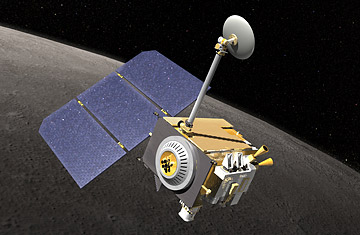
Lunar Reconnaissance Orbiter
From the moment Neil Armstrong planted his boot on the moon, we have felt well acquainted with the place. It's cold, cratered, dusty and sterile. What else is there to know?
Plenty, actually. So far, astronauts have visited only the relatively barren lunar equator — the moonscape of our imagination — and when Armstrong first landed on the surface back in the headstrong, computer-weak Apollo era, many of today's detailed reconnaissance technologies didn't even exist. So, scientists still don't know much about the moon's water-ice stores or its mineral composition or the variances in its gravitational field. No one has ever even seen the shaded regions at moon's poles.
That should change this fall when NASA launches its Lunar Reconnaissance Orbiter (LRO), a $491 million mission that will provide the definitive moon, finally enabling scientists to discuss it with the same level of detail as, say, Saturn or Mars. LRO will gather measurements from a low orbit of about 39 miles (50 kilometers) for a full year. The orbiter's camera will zoom in up to three times closer than the one-meter-resolution imaging from the 1970s (which was roughly as close as you can get to your backyard today on Google Earth). Researchers will compare LRO's images with the reams of on-the-ground pictures taken from astronauts' rover-based journeys around the moon. It will also study the Apollo 11 landing site, meaning that we might actually get another look at humankind's most famed footprint, nearly four decades later. LRO may in fact turn out to be an Apollo buff's dream: the orbiter will collect detailed images of every Apollo landing site, not for nostalgia but as part of a thorough search for landscape changes that could reveal how much space debris has walloped each site since the astronauts were last there. "We have no other place in the universe where we can compare [what it looked like] 40 years ago with what it looks like now, at almost the same resolution," says Jim Garvin, chief scientist at NASA's Goddard Space Flight Center and one of the space agency's earliest LRO proponents.
LRO's primary goal, however, is to understand the moon's big scientific enigmas in hopes of reopening lunar exploration to humans. Scientists want to probe regions like the rugged peaks of Copernicus and the permanently shaded poles of the moon, which have been blocked from solar illumination for some two billion years and may contain water-ice. They also hope to scope out potential landing sites for future manned missions. To that end, LRO's payload includes a camera high-powered enough to spot a football on the surface of the moon and a laser altimeter capable of measuring five-inch changes in the lunar landscape — that will allow scientists to assemble 3-D topography on a scale of inches rather than hundreds of feet. LRO will also map temperatures down to -508 degrees F (-300 degrees C) and sniff for water-ice deposits large enough to be scientifically useful, rather than a mere scientific curiosity. "The state of reconnaissance remote sensing has changed by an order of magnitude since Apollo," Garvin says. "We never had sensors that could measure like this when we first went to the moon."
From a navigation standpoint, LRO's biggest challenge will be maintaining its low-altitude orbit. The moon has no atmosphere, meaning there's no buffer against its irregular gravitational field, which will hurtle the low-flying spacecraft into unexpected dips and rises. "It's lumpy from the moon's mass concentrations," says Craig Tooley, LRO project manager. "That means as you travel around, you have to tune your orbit." If the orbit isn't properly tuned, he says, "you're at mountaintop level and you'll crash." There are other hazards too. LRO's instruments could either freeze or burn, since the moon's shaded regions are bitter cold (at least -279 degrees F) while the sunlit side is scorching hot (about 265 degrees F). Adapting the instruments to survive the extreme swings in temperature has proven a major design challenge.
Part of that difficulty stems from the mission's tight time frame, driven by President Bush's call to land humans on the moon by 2020. By LRO's scheduled launch this fall, it will have been a mere four years since the mission was dreamed up on lunchtime napkin scribbles —fast by interplanetary exploration standards. So, scientists have had to improvise: the spacecraft borrows designs from solar science missions and the infrared James Webb Space Telescope (slated to launch in 2013), while the instruments use elements from heritage equipment used on several Mars missions. LRO also incorporates a hat-tip to the old-school Apollo era — NASA is handling much of the construction in-house, at Goddard Space Flight Center in Maryland, rather than farming the work to contractors. To meet the fall launch deadline, Goddard engineers are building the spacecraft two shifts a day, six to seven days a week.
When LRO reaches the moon, it will have plenty of company, joining Japan's Kaguya, China's Chang'e 1, and India's Chandrayaan-1 (scheduled for launch this spring). "It's like the Oklahoma land rush," Garvin says. "The moon is doable, it's profound, and it's a catalyst for national technological pride by any country that goes." Despite their common destination, Garvin says there are few scientific redundancies between the missions. NASA is already coordinating LRO's observations with Chandrayaan's efforts, and the agency also has a collaboration agreement with the Japanese, who are sharing Kaguya's lunar gravitational data in return for NASA's tracking support.
That's a far cry from the old us-or-them space race mentality, and hopefully LRO's images will be equally distinct from the dusty moonscape we thought we knew so well. The next time we see Armstrong's boot print, we'll know it really was just one small step into a giant new world.